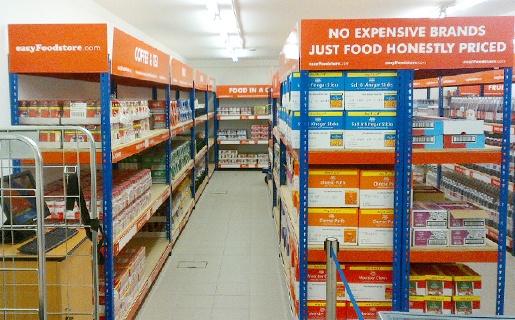McDonald’s Kale Salad Dishes out More Calories than a Double Big Mac


The past few years have not been kind to McDonald’s and its competitors in the fast food industry. Diners are flocking to fast-casual restaurants like Panera Bread, Pieology or Chipotle (until that company’s recent struggles) out of concern over the ingredients in their food.
McDonald’s sales improved last quarter thanks largely to rolling out an all-day breakfast meal, but the Golden Arches’ long-term prospects are still uncertain.
The fast food giant has tried to venture out of its comfort zone: It test-marketed organic hamburgers and regaled food writers by inviting a Los Angeles chef to cook a meal entirely out of McD’s ingredients. But the company still has a long way to go before it lures in the younger and health-conscious customers who are just not “lovin’ it.”
Speaking of health, McDonald’s has long offered salads but struggles to turn that menu offering into significant sales. After past marketing campaigns that mocked the very idea of kale, the company dabbled with that dark leafy green on the menu in test markets across the world. That sounds like a step in the right direction to attract the foodie and hipster crowds, except McDonald’s ran into a big problem.
It turns out that in Canada, McDonald's salads that include kale have more calories than a Double Big Mac.
The culprit, it turns out, is the salad dressing. Depending on the salad ordered, the amount of calories ranges anywhere from 280 to 520 — an amount not completely unreasonable. But upon adding the “pure” Asiago Caesar dressing, you will add 210 calories and 260 milligrams of sodium to your lunch. Options such as the “calorie-wise” Asiago or feta will heap another 300-some milligrams of sodium to your meal. So, that healthy craving for a salad with crispy chicken and a full ramekin of dressing will cost you the time at the gym to work off 730 calories and 53 grams of fat — more than a Double Big Mac.
For a company as under the microscope as McDonald’s, the lack of foresight is puzzling. The company takes months, even years, to test out new menu items. To its credit, it succeeded with snack items such as yogurt parfaits and chicken wraps (and that McD’s coffee!) that are not a complete coronary disaster. In this case, a simple vinegar-and-oil dressing with a secret and hyper-marketed blend of seasonings could have done the trick and avoided the embarrassment of just about every publication and blog playing the “gotcha” card.
And fresh ingredients aside, McDonald’s still has many questions about the health impact of its products, as in those additives and preservatives that have allowed a Happy Meal to remain intact after six years.
Image credit: McDonald’s Canada
How Big Data Can Make Your Company More Sustainable


By Roslyn Tate
Big data has become quite the buzzword recently, but for those yet unaware, let’s start with a definition: Big data refers to large collections of information that can be processed to reveal valuable insights. A common example of big data in action can be found in baseball, where teams have turned away from drafting players based on their popularly-perceived merit to judging them according to ever-growing reams of in-game statistics.
But big data isn’t just valuable for baseball teams; industry can leverage it as well to improve bottom lines. Data Science, a burgeoning new field of academia dedicated to collecting, organizing and analyzing information, has revealed how businesses can reduce costs and increase profits by relying on big data. Greater sustainability too is possible through the right applications of big data.
Greater sustainability through clearer inventory
Big data makes it possible to process large amounts of information on real-time conditions, which can help businesses make better-informed decisions about the production and distribution of goods. Not only does this cut down on costs, it minimizes the amount of materials consumed and waste products produced through manufacturing and shipping.
A real-life example of this is can be seen at Pirelli, the world’s fifth-largest tire manufacturer. Working with SAP, a German software company that offers businesses big-data solutions, Pirelli was able to outfit its inventory operations with sensors that deliver second-by-second data. The result is a clearer picture of where inventory stands and what needs to be produced, thereby helping Pirelli reduce redundant goods and deliveries, keeping tires from reaching landfills and greenhouses gasses from the atmosphere.
Greater sustainability through energy efficiency
Big data not only makes real-time conditions knowable, but it can also help businesses optimize their responses to it. In this way, not only are businesses aware of problems as they arise, they’ve already worked out the best possible solutions. This again increases efficiency while eliminating waste.
Another real-life example: The equipment in IBM’s data centers produces huge amounts of heat and requires cooling to properly function. Whereas IBM would, in the past, cool the entire facility, it has since developed mobile measurement technology that can identify isolated hot spots within the data center and target them with air conditioners or chimneys. Not only does this reduce the data centers’ energy consumption, but it also saves IBM quite a bit on its electricity bills.
Greater sustainability through integrated systems
It’s one thing for big data to allow goods to 'talk' to businesses, as in the case of Pirelli’s tires, or a system to talk to itself, as in the case of IBM’s air conditioning, but big data can also allow different systems to talk to one another. Many businesses rely on processes that, while interrelated, are often isolated, operating on their own in ignorance of what’s going on with the very relevant but utterly disconnected process next door. Big data can eliminate this barrier.
Take the case of Microsoft’s headquarters in Redmond, Washington. In an effort to reduce the redundancy of a comfortable workplace being the byproduct of an enormously wasteful competition between a building’s air conditioning and heating systems, the facilities team organized existing sensors into a single energy-efficiency system. Not only did this avoid the $60 million capital investment that the feat would have otherwise required, it discovered a garage exhaust fan that had been running for over a year, costing the company $66,000.
Greater sustainability through smarter predictions
We’ve covered how big data can be responsive, efficient and integrated, but it can also be predictive. It can leverage historical data as a statistical basis for future performance, allowing businesses to “see” what the future holds based on similar situations in the past, as well as model new outcomes, revealing what a course of action will yield according to the interactions of various influences.
This application of big data is perhaps most pronounced in the agricultural industry. Humans can encourage desirable traits in plants by cross-pollinating them, selecting the most promising new hybrids and repeating the process to reinforce those characteristics. This used to be a very time-consuming process as it required scientists to bring a seed to maturation, cross-breed it, bring that seed to maturation, cross-breed it, bring that seed to maturation, cross-breed it, and on and on. Big data is now allowing organizations like the Donald Danforth Plant Science Center to model the evolution of hybrid plants, reducing the development time dramatically. This, clearly, holds great promise for a more sustainable food supply.
While the possibilities of big data ushering in true sustainability are enormous, much of the work remains to be done and many of the rewards are far from being reaped. It’s the work of humans today that will create a more socially responsible, environmentally friendly and economically equitable world tomorrow. Businesses have a role in this by utilizing technology to make the smart decisions now. To that end, big data may be fittest tool available to you.
Image credit: Pixabay
Roslyn Tate is an editor of data science information on the 2U Inc. website. The data science team at 2U strives to provide aspiring analysts and entrepreneurs with the knowledge they need to choose the best degree for their goals.
Shattering Glass Myths: Design for Climate Action


By Smita Chandra Thomas
Imagine a man standing outdoors on a blustery cold day, wrapped in nothing but a flimsy sheet of plastic, trying to warm himself up with cup after cup of hot coffee. The same principle is at work in a building being pumped with hot air while clad in walls made of glass and steel, chugging away to keep the inside warm. Buildings encased in glass and steel are poor insulators, yet they are ubiquitous.
Why this matters
Poor thermal performance in buildings leads to higher loads on fossil fuel-fired heating and cooling systems, as well as larger renewable systems. The COP21 climate conference in Paris reiterated the urgency of reducing fossil-fuel energy use worldwide. The largest opportunity to meet this goal lies in buildings, globally the largest consumer of fossil fuels.
Top U.S. architectural firms have risen to the occasion and signed up for the Architecture 2030 Challenge to design new buildings with ‘zero’ fossil-fuel consumption by 2030. Zero-energy buildings are no futuristic dream either; while the exact definition of zero-energy is being hashed out, thousands of zero-energy units exist in the U.S. today.
The first opportunity to reduce energy use in buildings lies in the building skin, which can impact the total energy use of a building by 10 to 50 percent. And yet we continue to see buildings being encased in glass. Here are five myths surrounding glass skins that explain why this is cause for concern.
Myth: Glass is energy-efficient
Yes, there is energy-efficient glass, but only compared to other glass. For a building material, energy-efficiency chiefly refers to its resistance to heat flow (indicated by R-value), higher resistance being better. The table below shows some rounded R-values for windows versus insulation used in solid walls.
| Windows | R-value (ft2°Fh/Btu) |
| Single-pane window | Less than R-1 (close to metal) |
| ‘Efficient’ Double-pane and triple-pane window | R-2 to R-3 |
| ‘Top-of-the-line’ Electrochromic glass window | R-6 at center; R-5 or less including frame |
| Wall insulation | |
| Fiberglass batt insulation 3.5” thick | R-11 |
| Foam insulation- expanded polystyrene 3” thick | R-10 |
| Fiberglass batt insulation 6” thick | R-19 |
| Foam insulation - extruded polystyrene 6” thick | R-30 |
The table above illustrates that solid walls have much higher resistance compared to glass. Solid walls gain additional R-value (R-1 to R-2) from other material layers and air gaps, but may lose 10 to 30 percent from thermal bypasses such as floor slabs and wall ties. All things considered, a well-constructed solid wall resists the transfer of heat flow several times better than the best glass window.
Glass is also at a disadvantage because it allows more radiant heat gain by allowing sunlight to pass through – a significant problem in hot climates – even with Low-E glass. It is mildly helpful in cold climates during the short daytime hours with direct sunlight exposure, but not significant enough to make up for the heat loss through low resistance.
Some creative and high-tech solutions to combat heat transfer in glass walls include double-walled systems (which take up valuable urban space) and double-glazed ventilated wall systems whose thermal performance is only marginally better.
Myth: Buildings need lot of glass for natural light
Glass does serve the important function of providing daylight. It is worth noting, however, that it takes a fraction of full daylight to provide sufficient lighting inside a building for normal use. In fact, glare is a real problem in most all-glass buildings -- making the use of interior shading devices a necessity. Daylight can be introduced using other advanced technologies instead such as translucent insulation.
Smart design strategies include smaller windows with features that help daylight penetrate deeper into the space.
Myth: Buildings need a lot of glass to provide views
Windows are important for views, such as a grand view from an open space. But all glass walls on every floor are an overkill, impractical for interior furnishings, and can induce vertigo -- necessitating waste of space near walls in tall buildings.
Besides, views to the inside of an all-glass office building from an opposite building can be messy! Optimal window sizing and positioning, on the other hand, can provide strategically-framed views.
Myth: High-rise buildings need glass walls because they are lightweight
Glass-and-steel building skins are relatively low-weight, which makes them a practical choice in tall buildings. A typical insulated brick wall construction is about five times the weight of a glazed wall – not a good alternative. But other light-weight insulated options are available, such as exterior-grade metal-clad insulated panels – both thermally superior and aesthetically pleasing. The thermal performance of the metal framing— required for structural integrity – can also be improved by replacing smaller metal elements such as window frames with viable alternatives such as insulated fiberglass which is lighter and has better thermal properties.
Myth: Glass buildings are ‘green’
This is the mother of all myths. Confusion about the relationship between ‘green’ buildings and glass walls exists because many famous green buildings are clad in glass walls. The fact is, those buildings are efficient in spite of the glass walls, not because of them. As described above, glass walls have poor thermal performance. Green buildings encased in glass rely on other strategies to reduce energy use, and notable efficiency targets are indeed achieved. But starting with optimized exterior walls would take those buildings a whole lot further.
Time for a new international style of architecture
In short, glass building skins do not jibe with energy efficiency goals. They may appear seductive and iconic, but they disregard the environment.
Building designers who understand the basics of the path to 'zero' energy – designing passive design solutions before leaning on mechanical systems and renewable energy – can lead us away from all-glass to more sophisticated solutions. Will you do your part to spread awareness about this?
Image credits: 1. Wikimedia Commons 2. Guy Marsden (used with permission) 3. The Building Science Group (used with permission)
Smita Chandra Thomas is a U.S.-based sustainability consultant and a LEED AP with an undergraduate degree in Architecture, and a Master's in Building Science from the University of California (LA and Berkeley). For nearly two decades, Ms. Thomas has been focused on enabling energy efficiency in buildings through building science for lesser waste, greater economy, better health, and a sustainable environment for future generations. Ms. Thomas runs her private consulting practice Energy Shrink in Washington DC. She can be reached at <[email protected]>.
How Institutions of Higher Education Can Address Climate Change


By Meghna Tare
Keeping kids engaged and active is a challenging job. To keep them away from TV and video games, my family often engages them in board games, and one of our favorites is the The Settlers of Catan, in which Earth’s terrains — forests, fields, mountains, hills and pastures — produce resources essential to winning (not to mention surviving in the real world).
Catan's philosophy is to deal with a limited amount of resources in a sustainable and responsible way. Resources in the game include lumber, wheat, oil, ore, brick and sheep, all things that players must obtain and trade in order to develop. In Catan: Oil Springs, players can develop faster with the resource, but in doing so pollute and risk disasters associated with climate change. Those who opt to halt oil production get points for being a 'champion of the environment.' This game shows the extreme difficulty in prioritizing long-term wellbeing and security when there is so much pressure to maximize short-term growth — an essential lesson in today's growth-obsessed culture.
As a mom, and an educator for a university campus with over 35,000 students, I feel strongly that the younger generation should be given the chance to understand climate change as early as possible to help them with consumer choices. As their understanding of climate change grows, they will develop new attitudes about what is appropriate and moral. Young people may even grow up in a world where the relationships between nations will shift. As the generation that will face the reality of a changing climate in their own lifetimes, they are the most vulnerable yet potentially also the best placed (and most motivated) to generate an ambitious societal response that will avoid the most dangerous risks of climate change.
Colleges and universities can be climate champions, demonstrating through actions on their campuses what can be done to dramatically reduce greenhouse gas emissions, adopt sustainable operations and reduce waste.
Today, most campus sustainability initiatives comprise of cost-savings from the use of long-lasting CFL bulbs or double-paned windows. But economic benefit is not the only force driving change at institutions of higher education. We tap into the “moral imperative,” based on the concept that everything is part of the puzzle. It is important for us to not only draw the connections between natural ecosystem services and the economy, but also to communicate those connections to students and motivate them to take action. Students attending a university that places high value on issues such as climate change and sustainable growth are more likely to take this mindset to their future places of employment where they can help shape the future of environmentally-friendly companies.
During the build-up to COP21, the Globally Responsible Leadership Initiative ( GRLI) joined hands with a global alliance of universities, colleges and student networks. The partners aimed to inspire and empower students, academics, staff and academic leaders to make their organizations and communities more sustainable, resilient and just. They developed a joint statement and delivered it on Oct. 14 to senior government officials who planned to attend COP21.
This "network of networks" was inspired by the Higher Education Sustainability Initiative (HESI). The initiative was created as a partnership of U.N. entities (UNESCO, UN-DESA, UNEP, Global Compact, and UNU) in the run-up to the United Nations Conference on Sustainable Development (Rio+20). With a membership of almost 300 universities from around the world, HESI accounts for more than a third of all the voluntary commitments that came out of Rio+20.
The 2015 Global University Climate Forum was organized during COP21 in Paris. Sponsored by the International Alliance of Research Universities (IARU) with support from the International Sustainable Campus Network (ISCN), the Global University Climate Forum is a network of student teams from universities around the world who collaborate on initiatives that promote sustainability at their home institutions and study present innovative sustainability projects on campus. Student projects span disciplines and methods from app-based systems to reduce food waste to behavior-changing campaigns.
The forum embodies the saying “Think globally, act locally” by focusing on tangible, climate-based solutions that ultimately impact the dissemination of student awareness and consciousness about sustainable society.
Climate change and sustainability in the curriculum
The world faces not only a climate change crisis, but also threats to sustainability on all fronts. Thus, it is essential that colleges and universities formally acknowledge these transcendent problems and reorient academic programs to be relevant to the challenges all future graduates will face.
Higher education has an obligation to create campus climate-action plans that address the curricular component of this problem. The Carbon Commitment (formerly the American College & University Presidents’ Climate Commitment or ACUPCC) is a “high-visibility effort” to address climate change by creating a network of colleges and universities that have committed to neutralize their greenhouse gas emissions and accelerate the research and educational efforts of higher education to equip society to re-stabilize the earth’s climate.
The Carbon Commitment seeks to create connections with higher educational institutions in order to carry out two goals: The first is to make an agreement with these colleges and universities that they will commit to eliminate their net greenhouse gas emissions from specified campus operations. The second focuses on education and the institutions’ ability to promote research of sustainability programs and empower the “higher education sector to educate students, create solutions, and provide leadership-by-example for the rest of society.”
Calling climate change a defining issue of our time, United Nations Secretary-General Ban Ki-moon said that the opportunity exists “to define our own destiny." Institutions of higher education have the advantage to shape this destiny by educating the young generation on the impacts of climate change, the actions that they can take in personal and professional life to mitigate the impact, and ways to create a sustainable society where systems thinking is a way of life. Everything is part of the puzzle.
This post was updated on Feb. 12. An earlier version of this post referred to the Climate Commitment by its former name, the American College & University Presidents’ Climate Commitment.
Image credit: Pixabay
Meghna is the Executive Director, Institute for Sustainability and Global Impact at the University of Texas at Arlington where she works collaboratively to promote sustainability in greening facility operations, promoting innovative research, and supporting and encouraging student initiatives. She recommends policies and strategies to advance the university’s commitment to sustainability. She is a TEDx UTA speaker, holds an MBA in Sustainable Management, was featured as Women in CSR by TriplePundit, and is an active blogger. You can connect with her on LinkedIn follow her on Twitter @meghnatare or visit her website.
Saving The Environment: 9 Environmental Acts To Make A Habit in 2016


By Tim Sparke
A new year is always a good opportunity to try new habits and, when it comes to important issues like the environment, there really is no time like the present. Whether it’s improving your home to make it greener or simply paying more attention to the corporations and industries you support, there's always something to improve. Here are nine environmental acts to take up in 2016.
1. Home improvements
If there's one place you spend plenty of time in, it's your home. More than just saving power by turning lights off, what else can you do? Find the more creative solutions, and don't be afraid to invest in something that will save both money and resources in the long run.
If you have a garden, consider installing rain-harvesting tanks and water pumps. If you think about how much water you use, isn't it better to go for a natural source? Start making the big changes and you'll start contributing to big improvements.
2. Conscious eating
By now, you already know how to shop wisely – buy local produce and avoid materials that can't be recycled. Yet, the real world has much more issues than this. Take, for instance, where your food comes from. If you're buying Brazilian beef, you may be encouraging the deforestation of the Amazon. The same comes from not buying local produce – you should start to factor in all those transport costs.
This is the same whether you buy at home or, perhaps more importantly, when you eat out. Many people forget when they're at restaurants, or they simply don't want to ask the waiter a tough question. Refusing to pay for what you don't agree with is the only real way these companies will take notice.
3. Take political action
It’s one thing to improve your own life, but it's another altogether to take action and make big changes. While you're not a politician, you still have voting power behind you. Whether it’s campaigning against harmful new policies or trying to revoke existing ones, having the willpower to push for these changes is everything. Not only should you aim to sway politicians, but you can also use your passion to change the public mind. Join in campaigns, protests and actions for any cause you support.
4. Join a group project
On a similar note, it's always good to take action where possible and, often, it's better to take it as part of a team. There are plenty of group projects you could start or join. Don't have a garden?
Look into co-renting an allotment and providing green, local produce for your area. You could also look into improving your entire street or neighborhood with green improvements. If you want to save the planet as much as possible, you should look to encourage and include others.
5. Ditch the car
Anyone with a basic awareness of environmental responsibility is aware of just how damaging the vehicle is, yet we often still rely on it. Why not make 2016 the year you ditch the car altogether (except for emergencies)?
Cycling isn't just good exercise; it's a great way to get around! Also, don't be afraid to ride the bus and other public transport. This is often more fuel efficient compared to your own car – even when carpooling – so why use your vehicle at all if you can help it?
6. Embrace changes
From a psychological point of view, big life transitions are a good way to include other changes. This is just one of the reasons why we use a new year to become better people, but why not extend this further?
Whenever you start a new job or move to a new home, use this opportunity to become a new person. Identify the old habits that weren't helping the environment and change them completely. A big change like this is an opportunity for a clean slate, so make sure yours is as clean as it can be.
7. Learn to research
One of the best ways to argue your point – whether it’s suggesting greener methods to a local business or just encouraging greener thinking among your peers – is to come from a well-researched position. Facts speak for themselves and help you refute other claims.
In this day and age, there is a wealth of research showing how we damage the world. Use this to your advantage and support your arguments from a well-rounded position of strength. Many of the items listed in this list, such as conscious eating, will also improve as you discover just how big some problems actually are.
8. Push for information
On a similar note to research, don't be afraid to get the information you require. If you're eating out, ask where the beef comes from. Likewise, when you're going through potential energy providers, ask them for a detailed breakdown of their energy sources.
Whether it’s a legal requirement or not, companies should be willing to give this information out. If they don't, then it often suggests they have something to hide. Sometimes you have to stand firm on your ideals and push harder for the information you need to make the right decisions.
9. Set regular goals
It's one thing to make a simple change; it's another to push for more each and every time. When it comes to the environment, more is very much better. Whether it’s cutting down on power, relying on your own food or something else entirely, you should always set new goals. This encourages you to do more and allows you to chart your progress.
There are plenty of ways you can help the environment, whether it’s on your own doorstep or the wider world. The fact is, there's no excuse not to, so let these nine habits become your greener, eco-friendly way of life as 2016 continues.
Image credit: Pixabay
Tim Sparke is the CEO at 4pumps and for several years, he has been an active advocate of organic farming and sustainability. He also has a passion for writing and he writes the blog at 4 pumps.
The Challenges to Expanding Organic Cotton


We all know that buying organic is good for the environment. The benefits are multitude: less harmful pesticides and insecticides in the environment, lower water use, and, if done properly, improved topsoil.
That being said, some products provide even greater benefits if planted organically, and near the top of the list is something that nearly every American uses daily: cotton.
Cotton is in our clothes, our shopping bags, our bed sheets, furniture and numerous other products we come across daily. It also plays a role in our food supply through additives like cottonseed oil and cellulose fiber. It is also the backbone of a giant global industry, with supply chains connecting farmers across the world, laborers in textile factories, and retailers both online and in our neighborhoods.
Here’s the problem: Non-organic cotton’s impact on the environment is huge, which is why many say it may be the most important product to buy organic. According to the Roldale Institute, cotton is No. 1 crop in the world for pesticide use, consuming an astounding 16 percent of global pesticides. Many of those pesticides end up in water supplies around the world, including right here in the United States.
Moreover, cotton is one of the crops most intensively reliant on big GMO seed companies like Monsanto. With 83 percent of cotton coming from GMO seeds, it one one of the top four GMO crops produced in the world alongside soy (89 percent), canola (75 percent) and corn (61 percent). According to Liesl Truscott, these massive environmental costs need to be addressed.
“The main challenge is that the market doesn’t work properly – current economic rules don’t attach environmental and social costs to conventional cotton production, so the mainstream market is given a massive hidden subsidy as society and the environment bear these costs instead of the conventional producers,” said Truscott, fiber and materials strategy director and European director for the Textile Exchange.
This massive subsidy is why non-organic cotton remains much, much cheaper than organic cotton. Moreover, organic cotton is hard to find -- something I myself can attest you when I go shopping. And when I do find it, it’s expensive -- when it should be the opposite.
“The question isn’t why organic ‘costs’ more, it should be why conventional production is allowed to avoid taking responsibility for so many costs,” Truscott said.
This is one reason that organic cotton is having numerous challenges in growing its market share and making a strong business case for companies to shift to organic. Part of that is due to the system that put control of inputs like seeds into the hands of a few big companies -- organic seeds are difficult to procure and distribute to farmers. Even when they are available, getting them to farmers in developing countries where most cotton currently comes from is a challenge, as is building the capacity of these farmers to be able to go organic farming and receive necessary certifications.
“Prices, the timeliness of payment and market access are not always strong enough to offset the risk of investment made by the farmer,” Truscott explained.
Nevertheless, there are some bright signs in the industry. In 2014, organic cotton reversed a three-year trend and grew globally by 10 percent. More and more retailers, like C&A, which topped Textile Exchange’s 2014 Report for volume of organic cotton use, are incorporating organic cotton into their supply chains.
This won’t be easy. Companies can’t just purchase more organic cotton; they need to work with suppliers to ensure both quality and transparency along the entire chain. That includes working with initiatives like the Organic Cotton Roundtable to build farmer capacity to produce more organic cotton. Companies that understand this are the ones who will benefit.
“The most successful brands and retailers are implementing new ways of sourcing that involve a more direct relationship with producers, with longer term commitments that incentivize cotton farmers to go organic,” Truscott said.
The final piece of the puzzle is us. Consumer demand is why grocery stores all across the country now carry an increasingly wide array of organic products. The clothing industry is, sadly, far behind, but we can help change that. If more companies see a market for organic clothing products, then this can help address the challenges facing organic cotton all along its supply chain.
“Consumer 'appetite' is, of course, one of the key driving forces behind brands and retailers’ sourcing decisions: the stronger the consumer demand, the stronger the incentive for brands and retailers to make efforts to source organic cotton,” Truscott said. “Raising consumer awareness about the benefits of organic cotton is therefore very important.”
It's clear that organic cotton has a strong role to play in creating a sustainable future. Hopefully, with more impetus from companies, greater consumer demand and increased advocacy from organizations like Textile Exchange, soon it'll be just as easy to buy organic clothing as it is to find organic produce in your local grocery.
Photo Credit: Wikipedia Commons
Barclays, Credit Suisse Settle with Record Fines for Misleading Investors


The feds have notched another win against predatory banking tactics. In what is arguably the largest settlement of its kind, Barclays and Credit Suisse agreed in January to pay a total of $154.3 million in fines and interest for misleading dark pool investors.
The Securities Exchange Commission (SEC) and the New York State attorney's office (NYAG) announced the settlement last week, which includes an admission by Barclays that it broke the law when it told investors that they would be protected from predatory tactics. Barclays has agreed to pay a total of $70 million to the SEC and NYAG, while Credit Suisse agreed to pay $30 million in penalties each to the SEC and the NYAG, as well as $24.3 million in disgorgement and prejudgment interest to the SEC.
Dark pools are private trading venues that are not open to the public and often involve broker- or agency-owned block trades. While dark pool liquidity schemes offer several advantages to both lenders and investors, they have also come under increased scrutiny by SEC and state regulators. The recent string of indictments and fines against multinational trading firms follow assurances by regulators that there would be more monitoring of private trading venues. In July, ITG agreed to pay $20.3 million in fines for its subsidiary's role in trading against its dark pool investors. It was the largest series of fines to be lodged against an investment firm, but it wasn't an isolated case. BNP Internal Exchange, UBS and Liquinet Holdings have all been fined for amounts ranging from $1 million to $14 million over the past year.
While the SEC has approved a "test" run of a new trade-at rule that it believes may steer more traffic away from dark pool venues, the British government has taken a different tact when it comes to those banks that have been implicated and found guilty of misleading trading. In October, the U.K. Treasury Department introduced a clause in its finance bill that limits the ability of banks to claim deductions for compensation payments they were forced to make for illegal transactions. This week the chair of the department, Andrew Tyrie, called for further restrictions that would prohibit such banks from charging off other costs they may have incurred as a result of illegal trading. That includes the costs incurred overseas should they be implicated in a scandal in the U.S.
The federal and state fines levied against Credit Suisse and Barclays demonstrate an effort by regulators to change and monitor trading practices on U.S. soil. But will it be enough? SEC Chair Mary Jo White admitted in November that dark pools present significant challenges for both regulators and investors who may be in the position to take advantage of large block-trading opportunities.
"Among other challenges, it can be almost impossible for an investor to assess adequately the conflicts of interest that can arise for a broker-dealer" that is operating alternative trading systems like dark pools," White said.
The real question for many investors caught in years of banking scandals, however, is not whether the fines are adequate to match the financial tally of the crimes, but why jail time has not been factored into the penalties for bankers that broke SEC rules. Companies like ITC, which saw its shares plunge precipitously after it was fined, may pay heavily at the trading floor. But the individuals who promoted, ignored or failed to regulate predatory financial practices, some critics argue, may be the last to feel the pinch.
Image: Håkan Dahlström
Oil Lobby Trolls Obama’s New Tax Proposal


Late last week President Barack Obama announced he would include a $10 per barrel tax on oil in the FY2016 budget that his administration is proposing to Congress. The reason for that proposed levy is that the Obama administration figures the $32 billion that could be raised by such a tax could finance clean-transportation measures and public-infrastructure improvements.
The line item will not pass the Republican-dominated Congress, and even this president would not be able to enact such a fee by executive order (but such an attempt, mind you, would be fun, just to watch the Republicans foam at the mouth and talk about impeachment and executive overreach, again).
But never mind the fact that this proposal will go nowhere. The oil industry, which in the U.S. has arguably had its most productive years under Obama’s “all of the above” energy policy, is already up in arms over the idea of taxing domestic oil production and imports:
“The White House thinks Americans are not paying enough for gasoline, so they have proposed a new tax that could raise the cost of gasoline by 25 cents a gallon, harm consumers that are enjoying low energy prices, destroy American jobs and reverse America’s emergence as a global energy leader,” said American Petroleum Institute President and CEO Jack Gerard.
The cold, stubborn fact, however, is that Americans actually do not pay much for gasoline — and they never have, even when oil prices were hovering at triple-digits per barrel. True, Americans pay anywhere from 30 to 50 percent more than the world’s leading oil-producing countries. But let's take a look at the rest of the world: Hong Kong has the world’s highest gas prices, at about $7.80 a gallon. Most countries in Europe are paying approximately $5.30 to $5.70 a gallon to fill up their cars. The truth is that, out of all the advanced industrialized countries, gasoline prices in the U.S. have always ranked the lowest in the world.
Over the years the U.S. economy has shown that it is resilient enough to withstand high energy prices, as was the case in the late 1990s and a decade ago. The dynamics between energy, economics and consumer behavior are also changing. Despite low fuel prices, electric vehicle sales continue to rise, not fall; and even that defender of conventional economics, Goldman Sachs, predicts a surge in electric car sales in the coming years. EVs are performing better and have become more mainstream, and they're now less about reducing fuel consumption for consumers than great torque, quiet engines, less maintenance and, yes, avoiding that annoying errand of filling up at the station.
If there is any time to prepare for a more crowded future, to upgrade the country’s infrastructure and hedge against the inevitability that oil is a finite resource, the time is now — while fuel prices are at near record lows. This proposed tax as currently written would also be phased in over five years — only incrementally increasing the price of gasoline. And the oil industry’s wailing about price increases and their purported concern for consumers aside, Americans have shown that they are relatively price-insensitive when it comes to the purchase of gasoline.
Energy policy reforms have started worldwide as a reaction to current low prices. In fact, many countries in the Middle East, whether they are oil producers (UAE, Saudi Arabia) or heavy energy importers (Egypt, Jordan) have overhauled, or are considering serious changes, to their energy policies. The issue in the Middle East is the subsidization of fuel prices, which has consumed a massive portion of these countries’ budgets. But those days of cheap fuel prices are ending in that corner of the world.
Meanwhile, across the pond, low petroleum taxes, not to mention the years of energy subsidies for producers here in the U.S., have helped fuel American energy companies’ success over the years. Since World War II, much of the infrastructure built in the U.S. was for a transportation system reliant on oil. It is only fair to have those who have benefited from those policies over the past several decades pay for the upgrades and changes necessary for a 21st-century infrastructure and economy.
Image credit: Arb.ca.gov
New Data Debunks Some Data Centers' Clean Energy Claims


Recent claims by owners of large data centers that a large part of their operations are powered by renewable energy have skeptics coming out of from under their solar panels. Now, there is hard data proving that skepticism is valid.
A report just out by Lux Research casts a large shadow on some data centers' clean-energy claims. Scientists at Lux Research found the data centers frequently draw on far more coal-fired power with its much higher emissions than renewables. Companies such as Google, Amazon and Apple should be careful about the claims they make, lest they come across partly as PR stunts.
“They aren’t doing as much as they claim about sourcing their electricity,” said Ory Zik, Lux Vice President of Analytics.
Data centers throughout the country need a lot of power to run 24/7. They cannot rely on the intermittent supplies that come from solar and wind energy systems. As a result, they must draw electricity from the regional power grid. Solar and wind systems they have deployed or are developing can help supply renewable power to their centers and to power grids. But they supply nowhere near enough electricity on their own to run operate data centers reliably full-time.
To determine the roles that various fuels play in powering data centers, Lux scientists divided the U.S. grid into 134 regions with data that is updated monthly by the U.S. Energy Information Administration (see the chart above). This compares to the 24 regions in the “eGrid” dataset that center operators currently rely on, which is updated only annually, most recently in 2012.
“We found that Google underestimates its dependence on coal in four out of seven data centers, in particular in its Berkeley County, South Carolina, location,” Zik said. As a result, the emissions Google is linked to are likely larger than they estimate by 42,000 million tons of carbon dioxide per year. That’s the equivalent of about 8,500 additional SUVs on the road.
Zik said Amazon’s claims are off-base in 23 of its data centers in Virginia. Furthermore, the online retailer and Web services company is less than transparent about how it calculates its emissions, Zik continued. Those 23 centers use electricity from a grid that is powered 43 percent by coal, not 35 percent as inferred using the eGrid data set. This difference amounts to 85,000 million tons of carbon dioxide per year more, or about 5,000 households’ worth of emissions, according to Lux.
“We’ve made a lot of progress on this commitment,” Amazon claims on its website. “As of April 2015, approximately 25 percent of the power consumed by our global infrastructure comes from renewable energy sources. By the end of 2016, we intend to reach 40 percent.”
On its site, Google says “We're currently using renewable energy to power 37 percent of our operations and expect this to increase significantly in the next two years. In fact in our 2015 White House Climate Pledge, we commit to tripling our purchases of renewable energy by 2025.”
Amazon, Google and their industry brethren got their first dose of ‘heat’ on the subject in 2011 when Greenpeace grabbed what data were available at the time and issued its How Dirty is your Data report. The authors tried to shame the companies into using their relative wealth, transformative technology and corporate cultures to supply their operations with renewables.
Perhaps, then, there was an overreaction by PR-minded executives looking to get ahead of any controversy. But data tools such as Lux’s are catching up with them.
So, what’s their story now? Neither Google, Amazon nor Apple was willing to comment for the record by press time.
Alex Epstein, a contributor to Forbes and author of “The Moral Case for Fossil Fuels,” took a shot at Apple last month here, criticizing it for “energy accounting sleight-of-hand” by “concealing that the vast majority of computer energy use comes from coal-powered manufacturing and the coal-powered Internet.”
After a quick search, Apple has since yanked one graphic from its website cited by Epstein but this text, in the box above, remains on the site.
Power supplied to the grid in many parts of the country earns renewable energy certificates, or RECs for short. Those credits place a monetary value on every megawatt-hour of renewable electricity solely for its environmental attributes. The credits are meant to boost the value of renewable energy systems among participating states. But they should not be confused with actual electricity generation. The values of credits fluctuate with market forces. They can be traded among owners in states with renewable energy requirements. Too often, data center operators fail to make that distinction.
“With the tools now available, it’s time for data center owners to bring their energy decisions the same data-driven rigor they use in the rest of their businesses,” Zik said.
Looking at the big picture, the fact that Amazon, Apple, Google and others are striving for cleaner and more sustainable energy supplies should be commended. That said, if they want to claim it, they should back it up in step with their current business practices. As among the largest electricity users on the plant, they are leading by example. Let’s hope they just keep the cart behind the horse and be more transparent in justifying their claims.
Something else to note: Data going back to 2012 does not capture the quickly evolving generation landscapes in many states due to growth in natural gas and solar and the closure of dozens of coal plants. That alone should provide a more accurate picture.
Image credits: 1) Flickr/Tony Webster 2) Courtesy of Lux Research 3) Screenshot via Apple
EasyJet Founder’s Discount Food Store: A Symptom of London’s Growing Poverty?


It does not take much of a search to find appalling stories about the price of real estate in cities such as San Francisco and New York. Cross the pond and land in the United Kingdom, and one will find that rents in London are insane as well. Average rents are well over £2,000 (about $3,000) a month, to the point that many Londoners are spending as much as two-thirds of their income to put a roof over their heads. As much as 27 percent of Londoners live in poverty, and most of those people in such dire straits are working families.
Food banks are one way in which many Londoners can get by, but these charities are overwhelmed. One entrepreneur, however, is test-marketing a store concept that sells basic foodstuffs at a very low price. The pilot store is so successful that the Guardian reported its shelves were cleared out on opening day within a few hours; over the weekend, queues took as long as six hours and bouncers were called in to keep order, according to the U.K.’s top gossip news sheet.
Stelios Haji-Ioannou, the Greek-Cypriot shipbuilding magnate who founded the European discount carrier EasyJet, is the brains behind EasyFoodStore. Located in the northwestern neighborhood of Park Royal, this pilot store stocks only 76 white-label items. Classic British (and Indian-influenced) treats such as chicken curry, digestive biscuits, brown sauce, garbanzo beans, poppadoms and jelly babies are priced at 25 pence (36 cents) an item — a shopper can buy one of each item and have a grocery bill of less than £20, or below $30. The stores do not sell fresh meats, dairy or produce, but one on a limited budget could do a lot worse than to fill up on foods such as cut green beans, peach slices, pita bread and canned tomatoes.
Prices will only be 25 pence through the end of this month, but afterwards the store’s items are not expected to cost more than 50 pence, which is still a phenomenal deal and far cheaper than the likes of grocery giants Tesco, Sainsbury’s and Waitrose. The response was so overwhelming that a two-week supply of goods lasted only a day and a half, and the store was closed all day last Thursday to restock and prepare for the hoards of shoppers who lined up on Friday morning to stock up.
Haji-Ioannou has parlayed EasyJet’s rise into a bevy of other branded companies, including EasyCar, EasyBus, EasyGym and EasyPizza, and it's making money hand-over-fist. Nevertheless, the CEO has not forgotten his roots, nor has he overlooked the fact that the times have not been easy for many citizens in Cyprus and Greece. His family’s philanthropic foundation, which sponsors several educational, environmental and entrepreneurial initiatives, has also addressed the economic crisis in southeastern Europe. The Stelios Foundation’s Food from the Heart program distributes free lunches to residents of Athens, Piraeus, Limassol and Nicosia.
The jump from food charity to food retailer, therefore, is a seamless one for Haji-Ioannou, who plans on growing a chain of such stores based on how this pilot location performs. Based on the rapidly-emptied aisles, EasyFoodStore could catch on quickly, and food retailers would be wise to take notice. The vast majority of citizens do not want a handout, but they do want to pay a fair price for goods and services. In London, they will never catch a break on rent, but at least living in one of the world’s most expensive cities could become easier to bear with a lower food bill.
Image credit: Easy.com